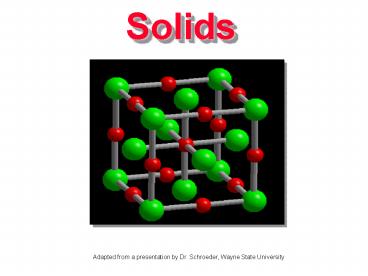Solids - PowerPoint PPT Presentation
1 / 18
Title:
Solids
Description:
CRYSTALLINE SOLIDS There are four types of crystalline solids Classified on a basis of the bonding or attractive force ... METALLIC SOLIDS Malleable and ductile ... – PowerPoint PPT presentation
Number of Views:272
Avg rating:3.0/5.0
Title: Solids
1
Solids
Adapted from a presentation by Dr. Schroeder,
Wayne State University
2
Properties of Solids
- 1. Definite shape, definite volume
- 2. Particles are CLOSE together
- 3. STRONG IM forces
- Often highly ordered,
- Rigid, incompressible
ZnS, zinc sulfide
3
SOLIDS can be arranged into two categories
- Crystalline Solids have a regular structure
in which particles pack in a repeating pattern
from one edge of the solid to another. - Amorphous Solids solids without form have
random structure and little long-range order.
Includes glass and many plastics.
4
CRYSTALLINE SOLIDS
- There are four types of crystalline solids
- Classified on a basis of the bonding or
attractive force holding them together - Molecular solids
- Covalent network solids
- Ionic solids
- Metallic solids
5
1. Molecular Solids
- Composed of atoms or molecules held together by
IMFs - Relatively soft, low mps, bps, etc.
- Water, carbon dioxide, NH3, Iodine (I2), sugar
(C12H22O11), and polyethylene are typical
examples. - Example Dry ice (CO2) sublimes at -78oC.
- Strong intramolecular (covalent) bonds
- OCO
- Weak intermolecular forces - London
- OCO
- ?- ? ? -
- Symmetric molecule, nonpolar
6
Molecular Solids (cont.)
- Example Polyethylene
- (-CH2-CH2-)n
- Polyvinyl chloride (PVC)
- (-CH2-CHCl-)n
- or
- H Cl H Cl H Cl
- ....C---C---C---C---C---C..
.. -
NONPOLAR - H H H H H H London Forces
7
2. COVALENT SOLIDS
- Form crystals that can be viewed as a single
giant molecule held together by an endless
number of covalent bonds. - Diamond is an example of a covalent solid.
Diamond is hard and difficult to melt (mp
3,550oC) because all bonds are equally strong.
Also graphite, quartz, and asbestos.
8
Diamond
Graphite
9
(No Transcript)
10
3. IONIC SOLIDS
- Are held together primarily by the strong force
of attraction between oppositely charged ions
(ionic bonds) - Are typically hard, brittle, and nonconducting
- High mps and bps
- NaCl and CsF are typical examples.
- Note the strength of the bond depends on the
radii of the formative ions. That is, the bond
becomes weaker as the ions become larger or the
ratio changes away from 11
11
(No Transcript)
12
Common Ionic Solids
- Zinc sulfide, ZnS
- The S2- ions are in TETRAHEDRAL holes in the Zn2
FCC lattice. - This gives 4 net Zn2 ions and 4 net S2- ions.
13
(No Transcript)
14
(No Transcript)
15
4. METALLIC SOLIDS
- Malleable and ductile
- Held together by metallic bonds
- Have their valence electrons delocalized over
many metal atoms. For this reason most metals
are good conductors. - sea of electrons model
- Jello with fruit
- Includes Au, Fe, Al, etc.
16
4. METALLIC SOLIDS
Atom core
e-
e-
e-
e-
e-
e-
e-
e-
e-
e-
Delocalized valence electrons (move around)
17
Types of Crysatalline Solids
- TYPE EXAMPLE FORCE
- 1. Molecular Ice, I2 Dipole London
- 2. Network Diamond Extended
Graphite covalent - 3. Ionic NaCl, CaF2, ZnS Ion-ion
- 4. Metallic Na, Fe Metallic
18
Amorphous Solids
- No regular geometric pattern
- More jumbled up
- Typically long chains of molecules that get
tangled up together - Classified on a basis of the bonding or
attractive force holding them together - Held together by IMFs
- Examples waxes, asphalt, many plastics































